|
accessibility.com.au - Travelling
Beyond The Front Gate By Matt Laffan
Matt Laffan In New York City
Updated : Friday 18 July, 2003
“I want to wake up in the
city that never sleeps
To find I'm king of the hill, top of the
heap
These little town blues
Are melting away
I'll brand a brand new start of it
In old New York
If I can make it there
I'll make it anywhere
It's up to you, New York, New York”.
With the immortal voice of Frank Sinatra
echoing in my mind I took it upon myself
to leave these beloved Australian shores
and head for New York City. As always I
regarded the journey as an adventure of
a lifetime. I had never been in NYC before
so I was a little unclear as what to expect.
However, I believed in the potential of
a spring visit to The Big Apple as one does
in the kiss of a new love.
As so often is the case with me and travel
it was the combined allure of good friends
and the exciting destination that got me
to cross the Pacific Ocean. Indeed my whole
NYC experience has been coloured by the
fact that I was able to stay with my friends,
Nic and Torie.
Nic is a great mate from my Sydney University
days. Through long hours, steadfast resolve
and with sheer flare and finesse he and
his wife Torie have both done very well
in NYC as they have carved out their independent
careers. This allowed me the unique opportunity
to stay a mere three blocks from Central
Park in a beautiful apartment. It was accessible,
close to the action, roomy and, most crucially,
free. This added bonus cannot be underestimated
because NYC is an expensive city. If it
were not for the hospitality of my friends
this journey would never have been fiscally
possible.
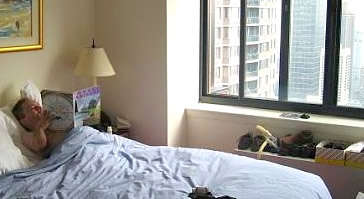
Apart from Nic and Torie I also got to
see Cissie, a dear friend who is now a successful
lawyer in NYC, and Sonia and her boyfriend
Marc, who live in New Jersey.
Thus in an unfamiliar city I had the comfort
of familiar faces to look towards for advice
as I found my way around a most exciting
destination.
In the following, I present to you a thumb
nail sketch of my experiences so that you
might be inspired to follow my own footsteps
and try the Big Apple.
Matt In NYC Index:
Getting Around:
Attractions:
Thoughts:
Getting Around
Transport
The Buses and Subways of New York City:
The cost of travel from the airport into
the heart of Manhattan is expensive! It
cost me $US72 to hire an accessible lift
care of Symphony Transit Services ('phone
1800 253 1443).
Although this fee seems extraordinary (which
it is!) the sad fact is that fares from
the airport into most capital cities in
the western world are expensive. This was
essential as you cannot hire accessible
taxis as we can here in Australia.
There is a fantastic subsidised service
available through Access-A-Ride but you
need to be given approval to use it some
three weeks in advance by writing to them
with particulars. Unfortunately I was not
organised enough to give this a try, but
I did notice plenty of the Access-A-Ride
vehicles servicing patrons. So I recommend
that you investigate them prior to leaving
to see what they can offer you.
Once in Manhattan the news is better.
The complete fleet of public buses is
accessible. This is a revelation for those
of us who live in the major cities of Australia.
We are in a situation of still agitating
for a far more extensive and reliable system
of accessible public transport. In Australia
we know only too well the routes are not
always guaranteed despite the best efforts
of the transit authorities because they
simply do not have enough buses. In NYC
it is a completely different story!
I traveled throughout Manhattan on the
bus system. In fact the buses took me from
the Upper West End of town, into Greenwich
Village, Soho and down by the Meatpacker’s
District. I even caught the bus across to
the Bronx so that I could attend Yankee
Stadium when I went out there to watch the
locals play ball.
The only problem with the service is that
they don’t run all night. In fact the routes
cease at different times depending upon
the stops. For example, if you are down
at 14th Street way near the Meatpacker’s
District the buses might cease to run after
11.30 pm. So it is essential that you make
sure you check out the timetable at your
pick up spot if you are spending an evening
out.
You don’t want to wander out of your favourite
jazz club to find that you have missed the
last bus and you have thirty blocks to walk
before you get home.
back
to the top of the page
NYC Subways
The traveling experience via the subway
is somewhat restricted by virtue of the
fact that there are only 50 accessible stations
out of a total number of 350. Although once
you locate an accessible station it has
to be said it is a great way to travel.
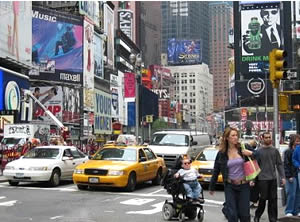
It is essential that you thoroughly investigate
the options available to you before you
climb on board and head in the direction
you wish to go as the distance between accessible
stations can be huge. You don’t want to
find yourself marooned far from home because
one of the places you expected to get off
did not fall within the 50 that are accessible.
Curb ramps, footpaths, road crossings
& shop fronts
New York City is like so many other big
western cities, it has great points to it
and bad ones when it comes to simple access
issues.
The city seems to be under constant construction
and re-construction. Where I was staying,
for example, in Columbus Circle there was
a great deal of building going on. This
meant the roads and footpaths were chaotic
with construction workers being required
to divert traffic and ensure that pedestrians
took an unbeaten path across town. Nevertheless
it was easy enough to negotiate.
Each district had a distinctly different
grade of accessibility. On the upper west
end of Manhattan I was impressed by the
curb ramps. They might not always have been
perfect but they were largely easy to negotiate
and on every corner. However, down in the
Soho District, which is highly fashionable
and a great place to swan about, the access
was not so good. On a couple of occasions
I found I had to walk for three or four
blocks along the road because the footpaths
did not have curb ramps.
Unfortunately one faces the same frustrations
you expect and find from Sydney too when
it comes to some restaurants and stores.
There are plenty of places with no access
into them, it might only be one or two steps,
but for the likes of me that is too many.
I know that the powers that be a trying
to address this issue and are doing so,
but NYC is a large, old and difficult to
manage city and it will take time. However,
as you will read from my examples of places
to eat, see and relax there is no shortage
of accessible stores and restaurants to
enjoy.
On the whole though the NYC street scape
is very accessible.
People who are visually impaired will
perhaps find it remarkable to learn that
NYC does not have street crossings that
have noise related monitors. That is unlike
here in Sydney you do not hear from the
beeping of the crossing when it is safe
or not safe to cross the road.
It so happens that a rather militant group
of the vision impaired society of NYC put
a stop to that means of assistance being
introduced by claiming that it marginalised
people with vision impairment in a political
sense.
To my mind this is an act of stupidity
as anything that can assist our brothers
and sisters with disabilities should be
seen as something that promotes ability
and independence rather than detracting
from it.
back
to the top of the page
Traveling on MTA Buses
Accessible Buses
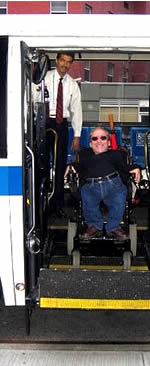 New
York City Transit and Long Island Bus serve
local and express bus routes throughout
the five boroughs and in Nassau and western
Suffolk counties. These routes connect with
many subway and commuter rail stations,
as well as key transportation hubs. New
York City Transit and Long Island Bus serve
local and express bus routes throughout
the five boroughs and in Nassau and western
Suffolk counties. These routes connect with
many subway and commuter rail stations,
as well as key transportation hubs.
The more than 4,300 buses in NYC Transit's
fleet are equipped with wheelchair lifts
and have a "kneeling" feature that lowers
the front entrance of the vehicle to within
inches from the ground for easy access by
any customer with mobility impairments or
difficulty using the front steps.
LI Bus provides wheelchair-accessible
service on all of its 54 routes and has
equipped its fleet of 323 buses with wheelchair
lifts and "kneeling" ability. Most LI Bus
vehicles will also be equipped with systems
that provide interior and exterior recorded
announcements.
All LI Bus routes have wheelchair lifts.
Timetables are available online in PDF format,
by calling 1 516 766 6722, or going to the
Hempstead Transit Centre, located between
Jackson and Columbia Streets in Hempstead.
Hempstead Centre is fully accessible; hours
are weekdays, 5 a.m. to 11p.m., Saturday
6:30a.m. to 9p.m., and Sunday 6:30a.m. to
8p.m.
Paying Your Bus Fare
To pay with a Reduced-Fare MetroCard,
dip the card in the fare box with the stripe
facing you. To pay a reduced fare in cash,
you need to have your identification and
the exact fare ready. When you use a token
on a New York City Transit bus, ask the
driver for a return-trip ticket. This is
good for 90 days from the date it is issued.
If you board NYC Transit buses via the
wheelchair lift, the driver will give you
a postage-paid, pre-addressed envelope to
pay your fare by mail. On LI Bus vehicles,
customers in wheelchairs can pay the driver
directly with cash or a Reduced-Fare MetroCard.
On LI Bus, transfers can only be made
between designated bus routes, and you pay
an additional 10 cents for a transfer if
you pay in cash.
All customers pay full fare on morning
inbound peak (6 to 10 a.m.) and afternoon
outbound peak (3 to 7 p.m.) express buses.
Boarding, Riding, and Leaving the Bus
- Wait near the bus stop sign where the
driver can see you and you can signal
to the driver.
- Make sure you have the correct bus by
checking the front destination sign, listening
to the recorded announcements on many
LI Bus vehicles and some NYC Transit vehicles,
or asking the driver.
- The driver will position the bus to
deploy the lift safely or operate the
kneeling feature.
- Priority seating for customers with
disabilities and senior citizens is located
behind the driver. Other passengers must
make these seats available upon request.
Please remember that some passengers may
have disabilities that are not visible.
- If you are in a wheelchair, position
yourself near the rear doors, where the
lift is located on most buses. The driver
will activate the lift, allow you to board,
and secure your wheelchair on the bus.
For added safety, please back your wheelchair
onto the lift and lock your brakes. Once
you are in position on board the bus,
lock your brakes again. All new buses
have seat belts and shoulder harnesses
for extra safety (Lifts can accommodate
customers with wheelchairs, scooters,
or other devices with a combined weight
of 600 pounds; the device and customer
must fit into a space 30 inches wide and
48 inches long).
- When you reach your destination, please
wait until the bus comes to a stop before
unlocking your brakes. The driver will
free your wheelchair from its position
on the bus and activate the lift to let
you disembark.
- If you have a visual impairment, please
listen closely for your stop when it is
announced by a recording or by the driver,
who will call out stops at major intersections.
You can also ask the driver to notify
you when your stop is next.
Please alert the driver when you want
to exit by pressing the strips located
in the area surrounding the windows. If
you miss your stop, tell the driver and
he or she will drop you off at the next
stop.
- NYC Transit has a Request-A-Stop late-night
service that offers customers the convenience
of getting off the bus at a location along
the bus route other than a bus stop, as
long as the driver deems it safe. The
service is available from 10 p.m. to 5
a.m., seven days a week. Just tell the
driver where you want to get off.
Personal Care Attendants
Personal Care Attendants or PCAs (people
employed to assist individuals with disabilities)
are eligible to ride MTA buses free when
accompanying a person who is carrying a
paratransit card that designates PCA assistance
is required.
Service Animals
Customers with disabilities are permitted
to bring their service animals into all
MTA transit facilities. The animals must
be securely leashed for the safety of all
customers.
back
to the top of the page
Traveling on MTA Subways
Accessible Stations and Subway Cars
New York City Transit subway and Staten
Island Railway (SIR) currently have 39 fully
accessible or wheelchair accessible stations.
As station renovation work continues, we
are creating more. NYC Transit is also continuing
to renew its subway fleet. Beginning in
the year 2000, thousands of new subway cars
are being placed in service. These incorporate
features to help individuals with disabilities,
including designated areas for wheelchairs,
computer-controlled announcement systems,
and improved signage.
Paying Your Fare
To use the subway turnstile, swipe your
Reduced-Fare MetroCard and your fare will
be deducted when the word "GO" flashes on
the turnstile screen.
To pay with a token, show your identification
to the station booth agent and ask for a
free return trip ticket before you enter
the turnstile. The return trip ticket is
good for 90 days from the date of issue.
On your return, give your ticket to the
station booth agent and you will be buzzed
through the service entry gate.
To enter through the service entry gate,
ask the station booth agent to open the
gate.
To enter through AutoGate, which is located
at the turnstile area in all fully accessible
subway stations, insert your Reduced-Fare
AutoGate MetroCard into the slot. Regular
and Reduced-Fare MetroCards will not work
at the AutoGate.
[Find out more information about applying
for Reduced-Fare MetroCard]
Hold your card so that the black stripe
is facing you and the cut-off corner is
at the top of the card. Put the card into
the AutoGate. The fare will be deducted,
the card will pop back up, and the AutoGate
will open. To leave the subway through an
AutoGate, insert your card into the exit
unit; the display screen will show the word
"GO," the gate will open, and no fare will
be deducted. The AutoGate MetroCard provides
the same free two-hour transfer as all MetroCards.
To leave the subway through an AutoGate,
insert your card into the exit unit; the
display screen will show the word "GO,"
the gate will open, and no fare will be
deducted. The AutoGate MetroCard provides
the same free two-hour transfer as all MetroCards.
Boarding, Riding, and Leaving Trains
To ensure that you have a safe, comfortable,
and convenient ride, follow these guidelines:
- Wait for the train near the centre
of the platform, where the car with the
conductor normally stops. An overhead
striped sign usually designates this area.
The conductor can be helpful in providing
travel information.
- All fully accessible and renovated stations
have two-foot-wide yellow tactile edge-warning
strips. Make sure that you stay behind
these strips until it is time to board
the train.
- If you are in a wheelchair, position
it about three feet from the edge of the
platform and facing the tracks, with brakes
locked. Never position your wheelchair
between a station column and the platform
edge. This creates an obstacle to passenger
flow and is a safety hazard for you and
the other passengers.
- At most stations there is a gap, about
four inches wide and two inches high,
between the platform edge and the subway
car; on curved platforms the space is
more significant. Please be extra careful
when crossing these gaps (The vertical
gap on accessible subway station platforms
is lower only near the centre of the platform,
near the conductor's position).
- Once on board, position your wheelchair
close to either end of the car and near
but not blocking the doors. Remember to
lock your brakes.
- If you miss your stop at an accessible
station, stay on the train until you reach
a station where you can transfer on the
same platform to a train in the opposite
direction and ride back to the station
you missed.
Tactile-Braille Subway Maps
NYC Transit and the Baruch College Computer
Centre for Visually Impaired People have
produced a series of raised-line Braille
maps with large-print backup for each subway
line.
Tactile-Braille overview maps of each borough
and station maps for 66th Street-Lincoln
Centre, Roosevelt Avenue-74th Street, Jay
Street-Borough Hall, and 59th Street-Lexington
Avenue are also available. These maps are
free.
To order, call Denise McQuade at 1-646-252-5031.
Your order will arrive in six to eight weeks.
Tactile Signage and Visual Displays
All fully accessible stations and newly
renovated stations have tactile-Braille
signage that is located on the left side
of the station booth and on the platform
columns nearest the stairs as well as on
other columns throughout the station.
Elevator/Escalator Hotline
We work hard to keep elevators/escalators
in good repair, but sometimes they are not
operating. Call the special hotline at 1-800-734-6772
or 1-718-596-8273 (TTY) to find out in advance
whether the elevator/escalator at your accessible
subway station is working.
Personal Care Attendants
Personal Care Attendants or PCAs (people
employed to assist individuals with disabilities)
are eligible to ride the subway system free
when accompanying a person who is carrying
a paratransit card that designates PCA assistance
is required.
Service Animals
Customers with disabilities are permitted
to bring their service animals into all
MTA transit facilities. The animals must
be securely leashed for the safety of all
customers.
Service Changes and Emergencies
For information about service changes,
particularly on weekends, look for a white
board in the station booth or ask the booth
agent. If your train is being rerouted from
an accessible station, ask the station agent
or a conductor to help you choose an alternate
route.
The conductor sits in the middle car of
the subway. If you are hearing or speech
impaired, you may obtain information from
transit personnel using handwritten notes.
If a mid-trip disruption in service makes
it difficult or impossible for you to reach
your destination, inform a conductor or
station booth attendant. The MTA will make
arrangements to get you to your destination
or help you return home.
Transit personnel will help you if an
emergency requires evacuation. Please follow
the instructions of these trained personnel
and the police. Some emergencies require
that stretchers be used to help customers
in wheelchairs leave the train. When this
happens, wheelchairs are removed separately
and returned to the owners as soon as possible.
back
to the top of the page
Attractions
The Empire State Building
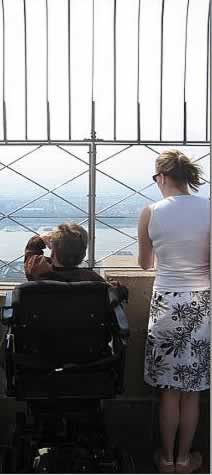 For
mere mortals the queue to get from the bottom
of the Empire State Building to the top
can take some three hours, such is the popularity
of the place. However if you have an obvious
disability the wait is significantly reduced
as I found I was warmly beckoned by the
security to the front of the line. People
with disabilities are given the royal treatment
and looked after superbly. For
mere mortals the queue to get from the bottom
of the Empire State Building to the top
can take some three hours, such is the popularity
of the place. However if you have an obvious
disability the wait is significantly reduced
as I found I was warmly beckoned by the
security to the front of the line. People
with disabilities are given the royal treatment
and looked after superbly.
All up the journey from the bottom to the
top took me around 15 minutes, once I waited
to purchase a ticket and waited for the
lifts, and I was absolutely delighted that
I am now one of more than a hundred million
other visitors who have been totally awed
by the magnificent view from the observation
deck.
I went on my last full day in NYC and
I am glad I chose to do it then. After having
been there ten days I knew my way about
the place on the ground so that by the time
I looked down on the crowded metropolis
I was able to easily pick out all the places
I had been.
From the 86th floor you could almost be
forgiven for thinking that NYC, home to
eight million people, is a quiet place as
one looks out from the observation deck
over the endless office blocks and residential
buildings in an almost eerie silence, broken
only by the chat of the other excited tourists
milling around.
It is worth bearing in mind that you will
find the the observation deck to be crowded
so you are best to take your time and relax
once you are there. Fortunately there are
various spots which make it easy for folks
in wheelchairs to get a good view.
back
to the top of the page
Statue of Liberty
www.nyctourist.com/liberty1.htm
It was a personal highlight to be aboard
the ferry and passing the Statue of Liberty.
For years of course she has posed as a central
figure of hope for immigrants arriving from
the four corners of the world seeking a
new start. This was not the case for me.
Being an Australian I regard myself as coming
from the best place on the planet anyway,
however, the 92.99 meter high structure
did pose as a significant feature for me
on my tour.
The great adventurer Sir Edmund Hillary
once remarked that with every great achievement
we make we must take the time to admire
the view. He was not simply saying that
because he reached the top of the world
for the first time, he was rather implying
that all of us need to take time out in
our daily pursuit of goals and achievements,
no matter how great or small, to realise
what it is we have done and to see how far
we have come.
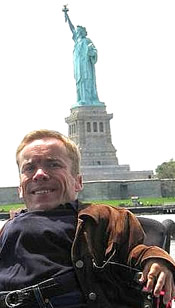
So for me the opportunity to be up close
and personal with the Statue of Liberty
provided such a moment in time. I really
did feel from looking into her face that
the places I had traveled, metaphorically
and physically, were special. She was, if
you like, my own touchstone as to what can
and has been achieved before turning one’s
mind to the next adventure.
back
to the top of the page
The Iridium Jazz Club
www.iridiumjazzclub.com
 1650
Broadway at 51st Street 1650
Broadway at 51st Street
New York, NY.
Telephone: 212-582-2121
Email: info@iridiumjazzclub.com
There was no way that I was going to NYC
and not have a jazz club experience. I was
determined to ensure that I would find a
jazz joint to fill up my soul and that I
would discover one with access.
Fortunately for me The Iridium was that
place and now that they are in their new
premises they have great access available.
True it is the wheelchair access is not
through the front door. But as we so often
discover the access is via a back entrance
and a lift which takes you down through
the bowels of the building but hey! you
are in NYC and everything is an adventure.
I recommend you do go there and when you
do be sure to get in touch with management
before you go and get a table reserved that
is easy to access. If you pre-plan have
them meet you at the front door to show
you the way in and things will work out
well.
I found the staff to be warm, generous
folks who made sure we were comfortable
before leaving us alone to simply enjoy
our friends, a beer or martini and the music.
Arthur, in charge when I was there, sounded
and looked as if New York Jazz had been
his way of life since he first leapt out
of his mother’s womb and reached for a smooth
whisky and a cigarette.
As an aside I should tell you that I was
fortunate enough to hear the Martial Solal
trio perform of whom I had not known before.
However, I learned that the brilliant jazz
pianist hales from Algiers, but is based
in Paris, so long a home for jazz musicians.
In fact as many of you probably know France
offered solace to many Afro-American jazz
artists during the years when they were
not regarded as equals in their own home
of America because of the colour of their
skin.
Solal, who is over 75 years of age, teamed
up with some younger French artists and
they played some magnificent music. It was
a great experience and something that I
regard as being a NYC must: Needless to
say, as this photograph illustrates, my
friends and I soon found ourselves befriending
a couple of the musicians after the concert.
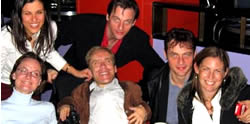
back
to the top of the page
On the Hudson & New York's Bridges
Seaport Cruise from
Pier 16 Ferry ride
www.bluescruiseny.com
One of the great tourist things to do
is to take a ferry or harbour cruise ride
out on the Hudson. There is a great deal
to see, drift up the Hudson and take in
the city skyline from the water. I went
with the one hour cruise and commentary
hosted by the Seaport Cruise from Pier 16
and it was a terrific option. We got to
see the Statue of Liberty particularly close
while having pointed out to us all the significant
buildings and bridges on the land. We came
close to Ellis and Governors Islands and
simply got a good feel for the significant
landmarks.
The access onto the boat was via a ramp
and as you can imagine the ease with which
one can negotiate depends on the tide and
the type of wheelchair you have. I personally
have a heavy electric wheelchair but I found
no problems with embarking or disembarking
as the staff were extremely observant and
helpful.
Although I did not do so myself, and I
regret the fact that I didn’t, you can walk
across the Brooklyn Bridge. It is arguably
the most influential bridge in American
history. Designed by the brilliant engineer
John Augustus Roebling (1806-1869) and completed
by his equally ingenious son Washington
Roebling (1837-1926), this elegant structure
was, at the time of its completion in 1883,
the longest suspension bridge in the world.
Anchored across the lower East River by
two neoGothic towers and a delicate lacework
of steel-wire cables, the soaring lines
of the Brooklyn Bridge have inspired countless
architects, engineers, painters and poets
to pursue their own expressions of creative
excellence, among them Frank Lloyd Wright,
Hart Crane, Walt Whitman, Georgia O'Keefe,
Joseph Stella, John Marin and Lewis Mumford.
The other significant bridges within this
stretch of the Hudson include The Williamsburg
Bridge The Manhattan Bridge and the Queensboro
Bridge. The latter has been immortalized
by Simon & Garfunkel in their hit song,
"The 59th Street Bridge Song/Feelin’ Groovy."
I got no deeds to do, no
promises to keep.
I'm dappled and drowsy and ready to sleep
Let the morning time drop all it's petals
on me
Life, I love you, all is groovy!
Ba da da da da da da ba bap a dee...
back
to the top of the page
New York Yankees Stadium
newyork.yankees.mlb.com
I saw the Yankees play on my very last
night in NYC and I booked my tickets to
the game before I even left from Australia.
If you are keen to catch a game (and I recommend
it to you) and you know your time table
it is a good way to do it over the web.
It takes the hassle out of doing it when
you are traveling and it ensures yourself
of making the game in advance.
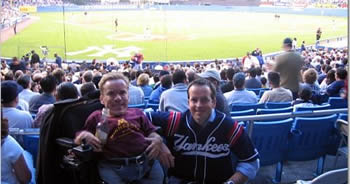
I booked the best available tickets and
found myself directly behind the catcher.
It was a fantastic authentic New York experience.
The wheelchair access was brilliant and
so long as you just give yourself plenty
of time to get there (I gave myself two
hours and just made it!) you will enjoy
it thoroughly.
The authorities need to improve the transport
for people with disabilities to and from
the Stadium. Quite unbelievably there is
no accessible subway station at the ground,
which surprised and disappointed me, and
the buses do not go directly to the ground.
I found I had to walk part of the way and
it was a little precarious as chauffeur
driven cars blocked the footpath leading
down towards the Stadium.
At the time there seemed to be some construction
work being done in the area which might
have contributed to the chaos, but it was
not as good as I would have expected.
But that all said it was a magnificent
experience. To see the most recognised sporting
team on the planet in full flight on their
home turf was very special even for this
non-baseballer!
back
to the top of the page
The Guggenheim Museum New York
www.guggenheim.org
The Guggenheim Museum is world famous
for its modern art and it usually hosts
a different exhibition every few months.
Once again it was another establishment
in NYC which took the waiting out of the
equation for people with disabilities and
their companions by taking us to the front
of the queue.
When I attended the Museum there was a
rather extraordinary exhibition by Matthew
Barney entitled: Cremaster Cycle (1994–2002).
I must admit to being a little dim of
wit when it comes to being receptive to
all things modern in art and this piece
of work challenged me no end. An art critic,
Nancy Spector, who wrote a piece for the
museum web site on the exhibition, describes
the work thus:
“It is a self-enclosed aesthetic system
consisting of five feature-length films
that explore processes of creation. The
cycle unfolds not just cinematically,
but also through the photographs, drawings,
sculptures, and installations the artist
produces in conjunction with each episode.
Its conceptual departure point is the
male cremaster muscle, which controls
testicular contractions in response to
external stimuli.
The project is rife with anatomical allusions
to the position of the reproductive organs
during the embryonic process of sexual
differentiation: Cremaster 1 represents
the most "ascended" or undifferentiated
state, Cremaster 5 the most "descended"
or differentiated.
The cycle repeatedly returns to those
moments during early sexual development
in which the outcome of the process is
still unknown—in Barney's metaphoric universe,
these moments represent a condition of
pure potentiality.
As the cycle evolved over eight years,
Barney looked beyond biology as a way
to explore the creation of form, employing
narrative models from other realms, such
as biography, mythology, and geology.”
And I am in no position to argue otherwise!
What I found most impressive was the way
in which Barney used the whole museum as
part of his artistic work. The museum is
a very large building.
The centrepiece of the installation was
a five-channel video piece suspended in
the middle of the Rotunda. Each screen showed
different footage from "The Order," a sequence
from Cremaster 3 shot in the Guggenheim.
Staged as a perverse competition with Barney
as its sole contestant, "The Order" deployed
five levels of the Guggenheim's spiraling
ramps in an allegory representing the five
chapters of the cycle. The exhibition mirrored
this structure — the Cremaster installments
progressed in ascending order from the Rotunda
floor, up the ramps, and to the Annex Gallery
at the top.
Sculptures introduced in "The Order" as
symbols for each Cremaster film were exhibited
in the context of their respective chapters
alongside earlier works in a chronological
rhythm that reflected the looping flow of
the cycle itself.
It was all a little demanding of this
Catholic lad from Sydney, but a fabulous
experience nevertheless.
What you have to be careful not to do
is miss the side rooms in the museum. As
it is in these side rooms that many of the
great permanent works are housed and be
it Monet, Manet, Picasso or some other celebrated
artist they are all here.
The access is first rate. Depending on
whether or not you feel comfortable negotiating
the large ramp that takes you up the five
floors you can access the various levels
by lift or walkway. I myself traveled to
the very top via the lift and then slowly
worked my way down via the ramp.
The accessible toilet takes a bit of work
to discover, but just ask one of the many
attendants on the ground floor where it
is you should go and they will direct you
accordingly.
back
to the top of the page
The Metropolitan Museum of Art
www.metmuseum.org
The MET is situated alongside Central
Park. It is a huge building with a magnificent
array and collection of art that it is difficult
to take in during one day’s meanderings
through the building. However, take yourself
off to the MET and indulge your senses.
The best thing to do, once again, is take
time. Lots of it. There is no sense rushing
around these places as the discoveries to
be made need time. I particularly liked
the atrium area that had little water fountains
and beautiful statutes. It was a magical
spot and accessed at various grades via
ramps that fitted nicely into the building.
There are plenty of bathrooms, one on
each level I think, and again it is only
a matter of asking one of the attendants
where you can find the accessible bathrooms
to ensure you head in the right direction.
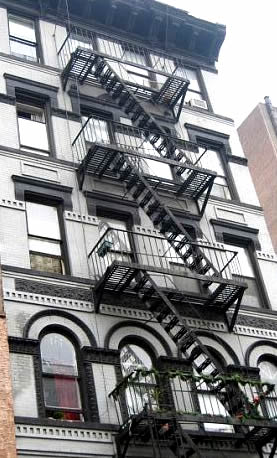
back
to the top of the page
Central Park
www.centralpark.org
Central Park is a massive area that like
the rest of the city takes your breath away.
Around eighty percent of the city’s greenery
is looked away within the park that contains
lakes, walks and open air concerts in summer.
Many movies and TV shows use Central Park
to shoot various scenes. Here are just a
few we've found:
Movies
The Fisher King
Many scenes shot within the Sheep Meadow
and along the perimeter of the park.
Balto
This animated movie released in the summer
of 1995 tells the story of Balto the sled
dog and his journeys. The animated version
of this statue in the Park is used for a
scene in the movie. The statue is located
North West of the Children's Zoo where 66th
street would cross if it went through the
park.
Ghostbusters
The huge marshmallow man terrorizes Columbus
Circle.
Wall Street
A young stockbroker confronts an inside
trader on Sheep Meadow.
When Harry Met Sally
Harry and Sally sip drinks in the Boathouse
Cafe.
Hannah and Her Sisters
In this Woody Allen movie, Hannah and her
sisters discuss the meaning of life while
strolling through Central Park.
TV Shows
The Single Guy
NBC's show begins with the main character,
Jonathan, sitting on a bench in Central
Park.
back
to the top of the page
Barrymore Theatre
243 W. 47th Street
New York, NY 10036 Theatre District
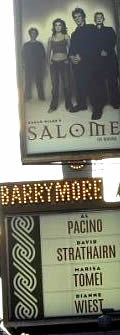 I
was fortunate enough to be taken to see
Oscar Wilde’s Salome at the Barrymore Theatre
just off Broadway. I
was fortunate enough to be taken to see
Oscar Wilde’s Salome at the Barrymore Theatre
just off Broadway.
It is a beautiful theatre that seats just
under 1100 people and it has very good wheelchair
access.
Salome was read and performed by Al Pacino,
Marisa Tomei and Diana Wiest and David Strathhairn.
It was an incredible experience. To be in
the comfortable, but tightly packed environment
in the heart of the NYC’s theatre district
seeing one of their home grown best, Pacino,
delivering a fantastic performance was truly
memorable.
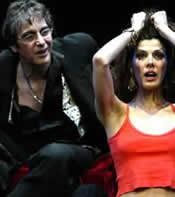
back
to the top of the page
Places To Drink and Eat
Arturo's
106 W. Houston St., Greenwich Village,
Tel. 212 677 3820
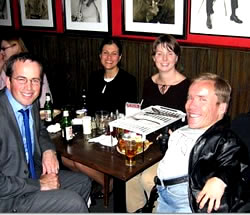 Arturo’s
was recommended to me by Australia’s very
own Bill Leak. Leak visited there many times
when in NYC and being a fellow artist he
fell in love with the crowded, live jazz
scene of the pizzeria. Arturo himself is
an artist and he has many paintings adorning
the walls. Arturo’s
was recommended to me by Australia’s very
own Bill Leak. Leak visited there many times
when in NYC and being a fellow artist he
fell in love with the crowded, live jazz
scene of the pizzeria. Arturo himself is
an artist and he has many paintings adorning
the walls.
It is a very cramped place which you enter
via a steep ramp at the front door. It is
popular with locals and therefore it is
crowded, so for those of us who need a little
space it is best to push out to one of the
back two rooms past the bar. Don’t let this
bother you because you will still hear the
jazz that plays there seven nights a week
and the pizzas, pasta and drinks will keep
coming for as long as you want to order
them.
The only hurdle is the bathroom. It is
accessible in as much that there are no
steps in the way, but it is very cramped
and could pose difficulties for a lot of
folks who use wheelchairs.
Pastis
Little West 12th Street (corner 9 Ninth
Ave) Meatpacking District
Tel: 212 929 4844
Pastis is by reference to its name very
French. It is a wonderful place, although
pricey for those traveling on a budget.
It remains the best spot to have a large
brunch following a late night out.
It has a bustling, attractive crowd that
fill it, and whether the patrons are in
the latest designer wear from Madison Avenue
or in casual jeans and an open shirt you
can be sure that there will be a star among
them. It is well renowned for its famous
and beautiful people and it is a great place
to get a feel for the Meatpacking District.
The access is superb.
Markt
401 W14th Street,
Tel: 212 727 3314
I called into Markt at the behest of a
mate of mine who loves sea food as it is
well known for its Belgium mussels. It is
a great pub with a super dining facility,
especially for those hankering for some
good Belgium tucker.
There is also a large variety of beers
on offer and apparently the Bloody Mary’s
are not too bad either. The access once
again is very good, and they have an accessible
toilet that is large and spacious.
Uncle nick’s Greek Restaurant
747 Ninth Avenue,
Tel: 212 245 7992
Uncle Nick’s has great access off the
street into its lively, excited restaurant.
It is full of people and the food is magnificent.
Like the rest of NYC it might seem a bit
cramped but I found I was able to negotiate
my chair into it and the table where our
party was situated relatively easily.
I did not check out the bathroom facilities
as we had to eat and run because we were
heading off to the jazz afterwards, but
everything else about Uncle Nick’s was marvelous.
The large open kitchen area was like its
staff, full of fire, fun and flavour!
Son Cubano
405 W 14th Street
Tel: 212 366 1640
www.soncubano.citysearch.com
I have never been to Cuba, but if the
music, food and atmosphere is any where
as half as good as this place it would be
a great country to see. Of course the Cuban’s
in America are a far wealthier type than
their brothers and sisters still in Castro’s
Cuba but they do not seem to have lost touch
with their roots. It was a really great
night spent in this restaurant.
The access through the front door was
via a gentle ramp leading to the front door.
The bathrooms on offer are not essentially
equipped for people with disabilities although
there was enough space to move around in
it.
It is a great place full of atmosphere
with live music at night beginning at 6
pm and ending at around 10 pm. Afterwards
a DJ starts his business. The band sang
wonderful Cuban songs with a real sense
of fun and celebration. The food is wonderful
and the sangria goes down a treat as there
is a real buzz to the whole place.
I recommend it as a dining highlight experience.
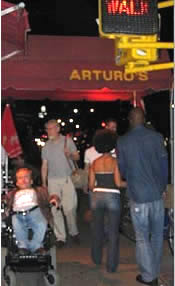
back
to the top of the page
Thoughts
Access and Politics:
When I had decided that I would visit NYC
I wanted to make contact with the local
authorities responsible for access issues
for people with disabilities.
The Lord Mayor of New York City, Mr. Bloomberg,
has a man appointed with that heavy responsibility,
Matt Sapolin. I was fortunate enough to
make contact with Sapolin from here in Sydney
via e-mail before I left and made me feel
warmly welcomed when I caught up with him
in his home city.
Sapolin being responsible for People with
Disabilities in NYC has an overwhelming
job portfolio. He and his small, dedicated
team are responsible for the roadways, footpaths,
both public and private buildings, transport
and all the other goods services as they
relate to folks with all kinds of disabilities.
It is a task he is taking on with enthusiasm
and a steely determination that is tempered
by both an understanding of how tough it
is and how demanding his constituents can
be.
It is worth mentioning too that Sapolin
is blind. For the likes of the sight seeing
me I find Sapolin’s tour of duty all the
more remarkable. The mind scape through
which Sapolin must pick his course and deliver
changes for the betterment of all people
with disabilities is daunting. We who have
light and shade and colour to fill our three
dimensional appreciation of how things are
would find the task of knowing NYC tough
enough without even turning our mind to
the task of solving the access issues that
the city has.
But Sapolin does not know the meaning of
impossible and you get the feeling that
he simply does not have time to be daunted.
With a great sense of humour, a genuine
sense of responsibility to the people of
New York, and a mind that regards the goals
he has set for himself and his charges as
being must do’s, he gets on with making
the changes he has set himself.
I spent a fantastic three hours with Matt
and his chief architect Robert Piccolo and
I got a strong sense that they know that
they have deadlines to meet and a heart
and minds and pockets war to win in ensuring
that access is increasingly delivered to
people with disabilities in the city that
is their home.
My experience in NYC made me think that
the city is in some ways no different to
my home town of Sydney. It has some great
access achievements under its belt and it
also has a great deal more to do. However,
what it requires, like here, is a willingness
by the powers that be to make it a priority
for change.
As I have often said a city’s sophistication
is best judged by the manner in which it
looks after the access issues for its citizens
and visitors with disabilities. If people
with disabilities find they have access
to entertainment, education, transport,
shopping, recreational and business opportunities
like the rest of the population you can
be rest assured that people with disabilities
will thrive. And as they do other areas
of diversity will also benefit which will
contribute to the greater community as a
whole and provide both social and fiscal
benefits that cannot be denied.
Like Australia the United States of America
is finding that the baby boomers are reaching
the age where hips and knees and backs are
no longer working as they used too, for
them access issues are becoming something
more than a passing interest. So that people
with disabilities and all that they have
championed by way of access issues are now
being joined by an aging population that
is used to being included and getting whatever
it is they want.
Here in Sydney and Australia there are
a few of us who are agitating for change
in our own positive ways, but there can
be no mistaking the fact that to make things
happen on a grand scale it will take money.
In NYC I hope that Mayor Bloomberg might
be savvy enough to have regard for the efforts
of Sapolin and his team and see what it
can offer the city overall. After all he
backed his own campaign for office with
a personal investment of eighty million
American dollars.
If he invested half of that in access issues
and called upon business to match it he
would ensure himself of not only leaving
a legacy for people with disabilities in
his city, but he would be setting the bench
mark for the rest of the world as to what
can and should be done.
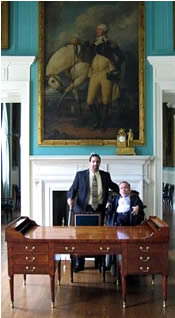
I was very lucky to be taken on a private
tour of City Hall with Sapolin which revealed
the history of the place. We even made it
into a new room that has been specifically
re-opened and commissioned by some of the
wealthy members of the NYC community. This
allowed Sapolin to show me a desk made in
honour and for George Washington in 1789
behind which we are photographed.
back
to the top of the page
Living A Movie Experience
 The
strange thing about being in NYC is that
you cannot escape the feeling that you are
living a movie experience. Or, at the very
least, you are playing some bit part in
a television show. The
strange thing about being in NYC is that
you cannot escape the feeling that you are
living a movie experience. Or, at the very
least, you are playing some bit part in
a television show.
We are so saturated by American television
and film that NYC seems somewhat familiar.
The steam rising up from the subways, the
yellow cabs and the flashing blue lights
atop the New York Police Department cars
as they speed down an avenue at first seem
too corny to be real. In fact at times you
kind of expect a character from Sesame Street
to appear. All around you accents distract
your ear as folks speak with that New York
talk that you recognise from episodes of
Welcome Back Kotter.
However, it is a thrill a minute as you
realise everything you have heard about
the hustle and bustle of the city is true.
Times Square has huge neon signs and billboards
that explode in colour throughout the day
and night. All around the streets people
are rushing to destinations unknown as fleets
upon fleets of yellow cabs race ahead of
other vehicles. With my first glimpse of
it all I thought pedestrian wise that Time
Square was not much different to Pitt Street
Mall on a busy day.
But then I realised after an hour or so
that I was not seeing the same faces pass
me by, where in Sydney I would expect the
same people to be circulating in and out
of the stores.
Times Square was instead a bustling thoroughfare
of commerce that entertained me for ages
just by sitting and watching people, whether
it was the street vendors or the shoppers
themselves.
It is an incredible experience being in
NYC as every area of it has something rich
to offer you by way of history, folklore
or through the sheer experience of the moment.
back
to the top of the page
back
to Matt's accessibility.com.au articles
|